Cycling Crete: Greece’s Island of Mountains and Myths
Your complete guide to Crete: the best routes, local insights, and must-see spots across Greece’s largest and most diverse island.

Quick links
Greece’s largest island is a world of its own — wild, mountainous, and deeply storied. Here, cycling means tracing routes where gods were born, empires rose, and mountain villages still echo with tradition. It’s a place that rewards curiosity as much as endurance, offering a perfect balance of cultural discovery and natural wonder.
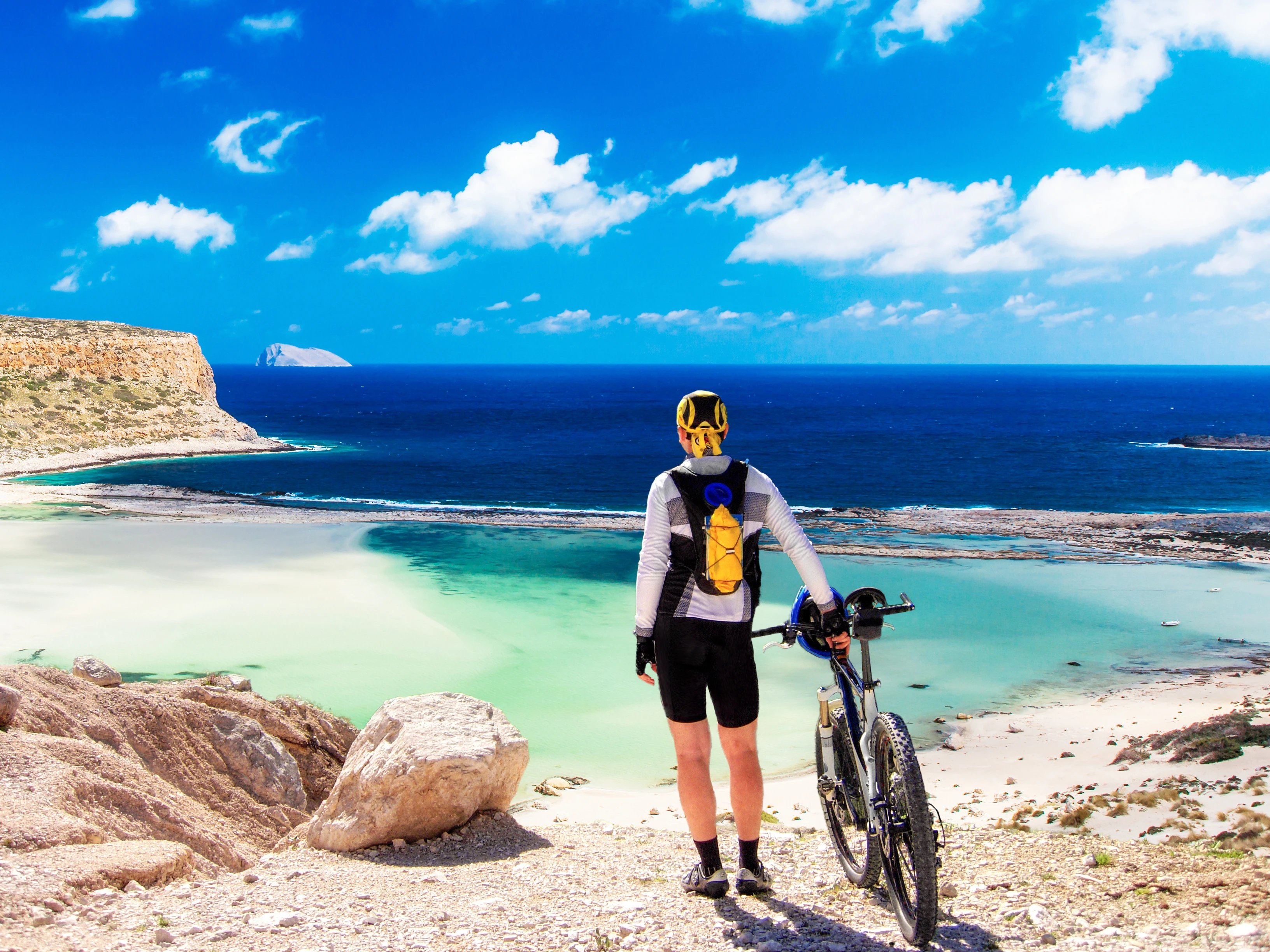
Why Cycle in Crete
Crete is Greece’s largest and most varied island — as you pedal from coast to countryside, the landscape shifts constantly — from palm-fringed beaches to high plateaus dotted with windmills.

Roads are quiet, the scenery is bold, and every stop brings a taste of real Cretan life. For riders seeking a mix of challenge, discovery, and Mediterranean warmth, Crete provides.
Quick Facts About Crete
- Total area: Around 8,300 km² — Greece’s largest and most geographically diverse island.
- Location: Southernmost island in the Aegean, halfway between Europe and Africa — giving it a unique climate and character.
- Geography: Four mountain ranges, fertile plains, and over 1,000 km of coastline — all within a day’s ride.
- Culture: A mix of Minoan, Venetian, and Ottoman legacies seen in architecture, cuisine, and local customs.
- Climate: Over 300 days of sunshine a year; mild winters and warm, dry summers.
- Highlights: Ancient Knossos Palace, Samaria Gorge, mountain villages, and pristine beaches — Crete combines history, wilderness, and authentic Greek life.
Crete is Greece’s most rewarding island for cyclists — big enough for multi-day tours, but compact enough to cross from coast to coast.
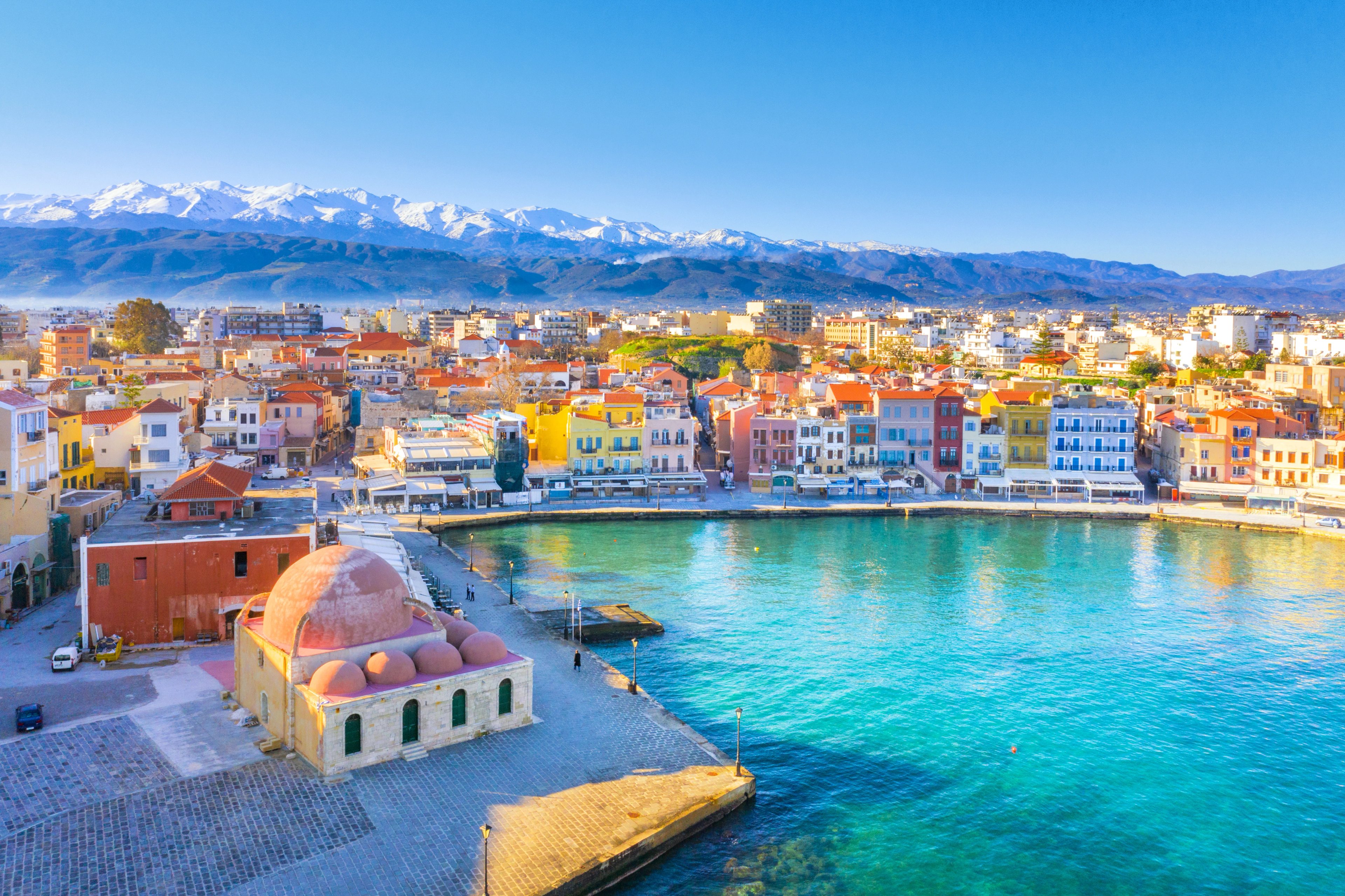
It’s a place where mountain challenges meet sea views, and quiet backroads lead through olive groves, gorges, and centuries-old towns.
What makes cycling here special:
- Varied terrain: From smooth coastal highways to rugged mountain loops.
- Long, scenic routes: Distances from 40–100 km a day with steady climbs and satisfying descents.
- Road quality: Excellent asphalt in most regions; minimal traffic inland.
- Cycling freedom: Explore without crowds — roads and trails stay calm even in peak season.
- Local flavor: Frequent stops for seaside cafés, small wineries, and traditional tavernas.
- Support & infrastructure: Bike-friendly hotels, e-bike availability, and growing route signage across the island.
Crete vs. Other Greek Islands
Crete feels like a world of its own — vast, dramatic, and layered with stories that stretch back thousands of years. At 260 kilometres long, it’s Greece’s largest island and one of the few where you can cycle from sparkling beaches to alpine plateaus in a single ride. Its scale, geography, and history make it unlike anywhere else in the Mediterranean.

The island’s three great mountain ranges — the White Mountains, Psiloritis, and Dikti — shape not only its terrain but also its mythology.
According to legend, Zeus, king of the Greek gods, was born in a cave on Mount Dikti, hidden from his father Cronus. Later, the island became the heart of the Minoan civilization, Europe’s first advanced culture, whose capital at Knossos inspired the myth of the Minotaur and the Labyrinth.
Today, traces of this layered past are everywhere — from Minoan ruins and Byzantine monasteries to Venetian ports and Ottoman fortresses. Riding through Crete often feels like pedalling through time, with each climb and descent revealing a new era of its remarkable history.
When to Go?
Crete’s location at the crossroads of Europe, Africa, and Asia gives it one of the mildest climates in the Mediterranean — perfect for cycling most of the year. While you can technically ride from March through November, the best months balance warm temperatures, calm winds, and open services. Expect dramatic seasonal contrasts: wildflower-covered hills in spring, dry golden plateaus in summer, and quiet coastal roads in autumn.
Seasonal Highlights
- Spring (March–June): Blooming landscapes, ideal temperatures, and quiet roads.
- Summer (July–August): Warmest weather, long daylight, lively coastal towns.
- Autumn (September–October): Mild conditions, crystal-clear air, and peaceful routes.
- Winter (November–February): Off-season for cycling — mountain areas can be cold and wet.
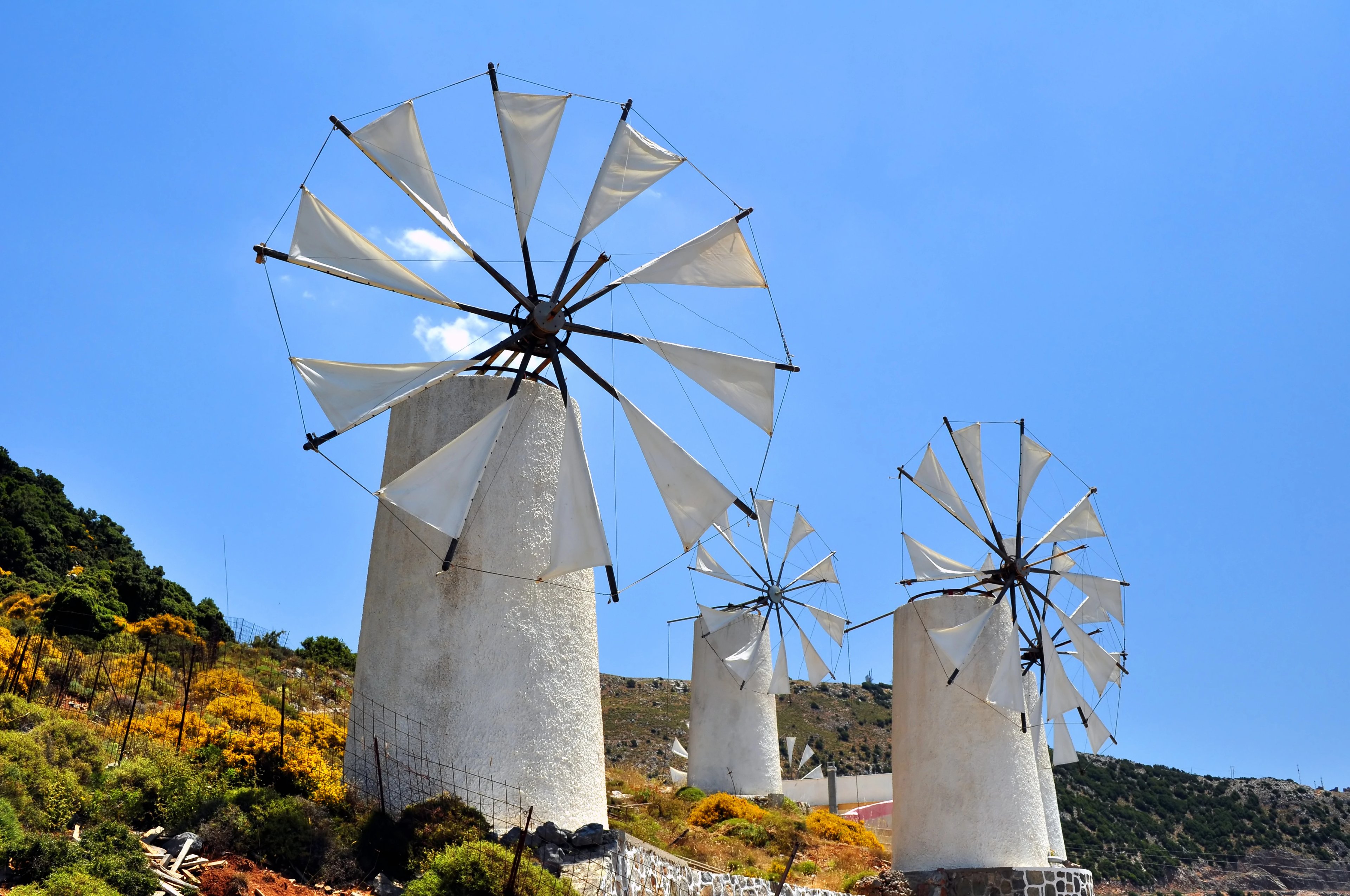
Spring (March – June)
This is the ideal season for cycling in Crete. The countryside bursts with color — wild herbs, olive groves, and blooming almond trees line the routes. Temperatures are warm but not hot, and most services are open from April onward.
- Weather & Temperatures: Expect highs between 18–25 °C with minimal rainfall.
- Trail Conditions: Roads are clear and firm, especially on the southern coast and low plateaus.
- Experience: Quiet, green, and fresh — the best balance of comfort and scenery.
Summer (July – August)
The island’s dry, sun-soaked summer offers long days and sparkling seas — ideal for combining cycling with swimming breaks. However, midday heat can be intense, so early starts are key.
- Weather & Temperatures: 28–35 °C near the coast, cooler in mountain areas.
- Trail Conditions: Excellent, with dry, fast roads and little chance of rain.
- Experience: Vibrant atmosphere, bustling beach towns, and full access to all services.
Autumn (September – October)
A favorite time for seasoned cyclists — still warm, but calmer and more relaxed than midsummer. The sea is at its warmest, and the harvest season brings a local, authentic feel.
- Weather & Temperatures: 22–28 °C, with cooler mornings and golden light.
- Trail Conditions: Smooth and reliable; occasional light rain refreshes the scenery.
- Experience: Ideal for cultural and long-distance rides with fewer crowds.
Winter (November – February)
Winter brings cooler air, shorter days, and the occasional mountain snow. While lowland roads remain open, this is not the best time for full cycling tours.
- Weather & Temperatures: 12–18 °C, with rainfall increasing in December and January.
- Trail Conditions: Coastal rides possible, but mountain routes may be slippery or closed.
- Experience: Great for relaxed short rides or hiking — not for full touring itineraries.
Curious to find out more about cycling-friendly seasons across the rest of Greece? We’ve got you covered in our Greek weather guide.
The Flavors of Crete
Crete’s cuisine is as distinctive as its scenery — simple, seasonal, and full of Mediterranean flavor. Every region has its own specialties, from mountain cheeses and honey to fresh seafood and garden-grown vegetables. Meals here are slow, social, and deeply tied to the land — perfect for refueling after a day on the bike.
Cyclists quickly learn that food in Crete isn’t just fuel; it’s part of the experience. Expect olive oil pressed from centuries-old groves, grilled vegetables drizzled with herbs, and local cheeses like graviera or mizithra served with crusty bread. In mountain tavernas, you might find dakos, the island’s famous barley rusk topped with tomatoes and feta, or a glass of homemade raki shared by your hosts.
What to try along the way:
- Dakos: Barley rusks with tomatoes, olive oil, and cheese — Crete’s most iconic dish.
- Kalitsounia: Small pastries filled with local cheese or wild greens.
- Staka: A creamy butter made from goat’s milk — rich and unique to Crete.
- Mountain honey: Often infused with thyme or pine, perfect for breakfast or snacks.
- Raki or Tsikoudia: A strong, clear spirit served after meals as a gesture of welcome.

Crete’s food culture is rooted in generosity and authenticity — the same qualities that define its cycling routes. For more on local dishes and food experiences across Greece, see our Greek food guide.
Key Cycling Routes and Regions
Crete isn’t defined by one long-distance cycling trail but by a network of diverse routes that connect coastal roads, mountain loops, and fertile plateaus. Most routes are on well-paved, low-traffic roads, with climbs that balance challenge and reward.
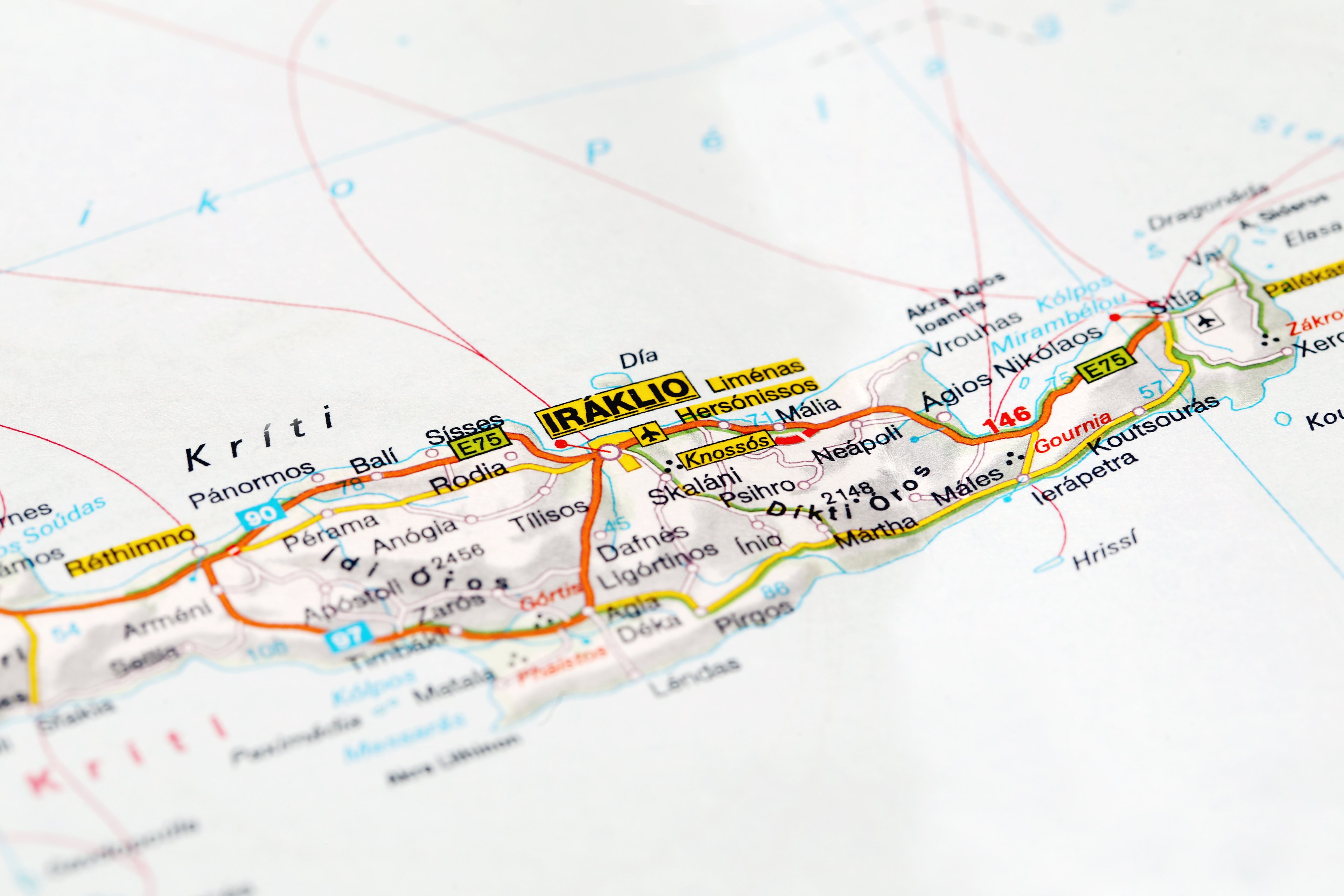
Top cycling areas and routes to explore:
- Chania to Kissamos Coast: A scenic western stretch along the sea, dotted with fishing villages, olive groves, and dramatic cliffs.
- Lassithi Plateau Loop: A highland ride surrounded by windmills, fertile farmlands, and panoramic views of the Dikti Mountains.
- Rethymno to Amari Valley: A cultural inland route through quiet villages, monasteries, and gorges framed by Mount Psiloritis.
- Heraklion – Knossos – Archanes: Combine history and cycling as you ride past ancient Minoan ruins, vineyards, and terraced hills.
- South Coast Route (Chora Sfakion – Frangokastello): A rugged, off-the-beaten-path ride with coastal climbs and turquoise coves.
Together, these routes showcase Crete’s full range of cycling experiences — from breezy coastal touring to adventurous mountain ascents, all steeped in history, hospitality, and sunlit Mediterranean beauty.
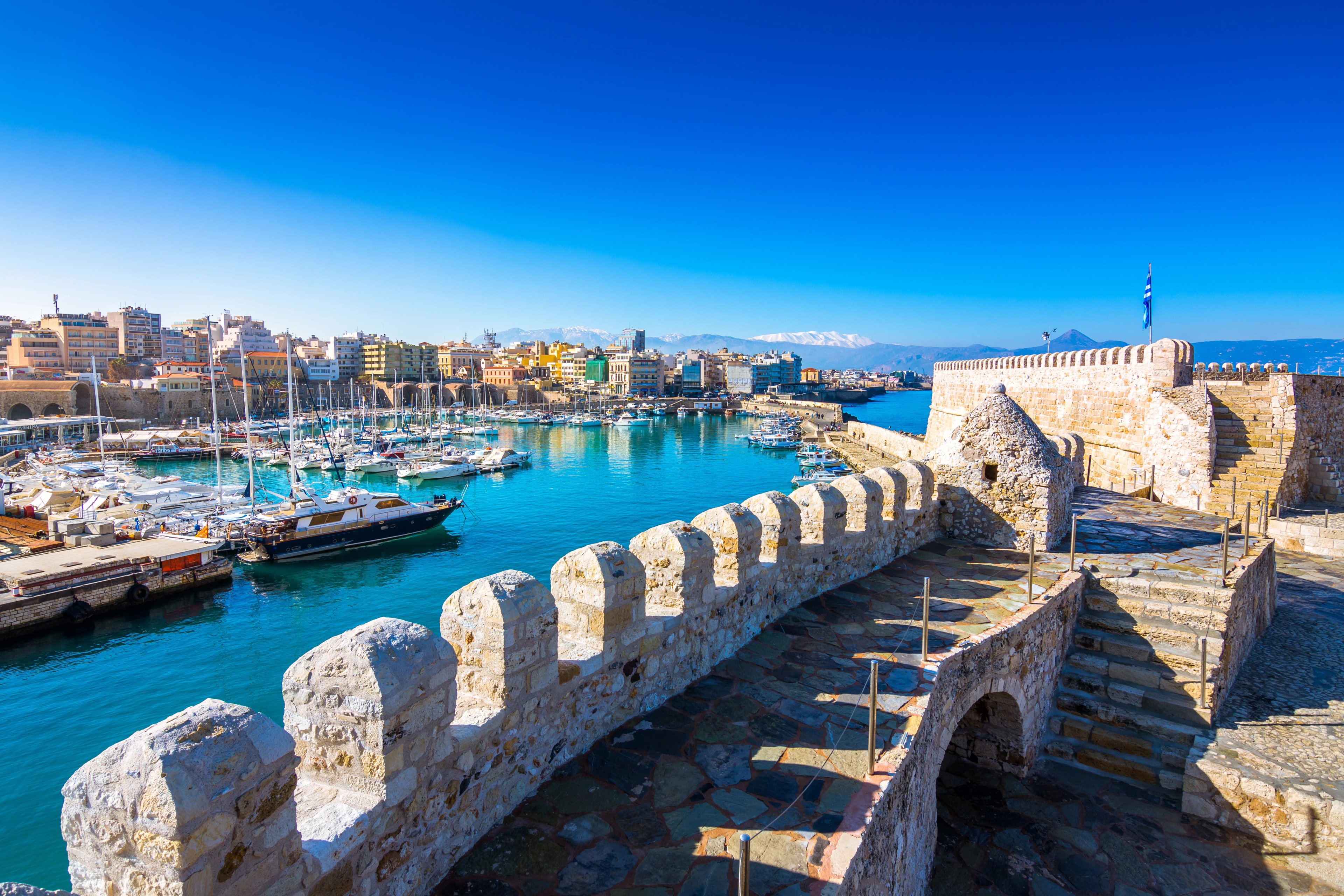
We’ve saved you the time of researching and mapped out the very best of Crete — combining its coastlines, mountains, and cultural landmarks — in our Crete cycling challenge, designed to showcase the island’s most scenic and rewarding routes in one seamless journey.
See it here:
Suggested Itinerary
Day 1: Arrival in Crete

Arrive on the island and settle in at the southern coast near Agia Galini. Spend the evening exploring the harbour and enjoying a relaxed seaside dinner as you prepare for the adventure ahead.
Day 2: Warm-up Ride to Matala

Begin your cycling journey with a scenic 60 km loop to the village of Matala, famous for its sandstone caves and relaxed coastal vibe. After a gentle climb at the start, the route levels out with olive groves, sea views, and a smooth return to Agia Galini.
Distance: ~60 km
Elevation: +830 m
Surface: Mostly paved rural roads with light traffic; short coastal gravel stretch.
Day 3: Asterousia Mountains

A full day of challenging climbs through the Asterousia Mountains, combining mountain views with cultural stops. Ride past the ancient site of Gortyn, home to Europe’s oldest legal code, before tackling steep gradients and panoramic descents.
Distance: ~100 km
Elevation: +1,620 m
Surface: Fully paved mountain roads with long climbs and winding descents.
Day 4: Messara Loop

Cycle through peaceful villages and vineyards across the Messara Plain, then ascend toward Festos, an ancient Minoan palace with sweeping valley views. Expect long but rewarding climbs and wide-open landscapes.
Distance: ~125 km
Elevation: +1,560 m
Surface: Paved roads throughout; narrow lanes and smooth countryside asphalt.
Day 5: Zaros

Head into the Ida Mountains toward Zaros, known for its freshwater springs and serene lake. The climb is steady, the scenery lush, and the descent offers thrilling views of the Gulf of Messara.
Distance: ~70 km
Elevation: +1,260 m
Surface: Smooth asphalt roads; short gravel section near Zaros Lake.
Day 6: Kourtaliotiko and Kotsifou Gorges
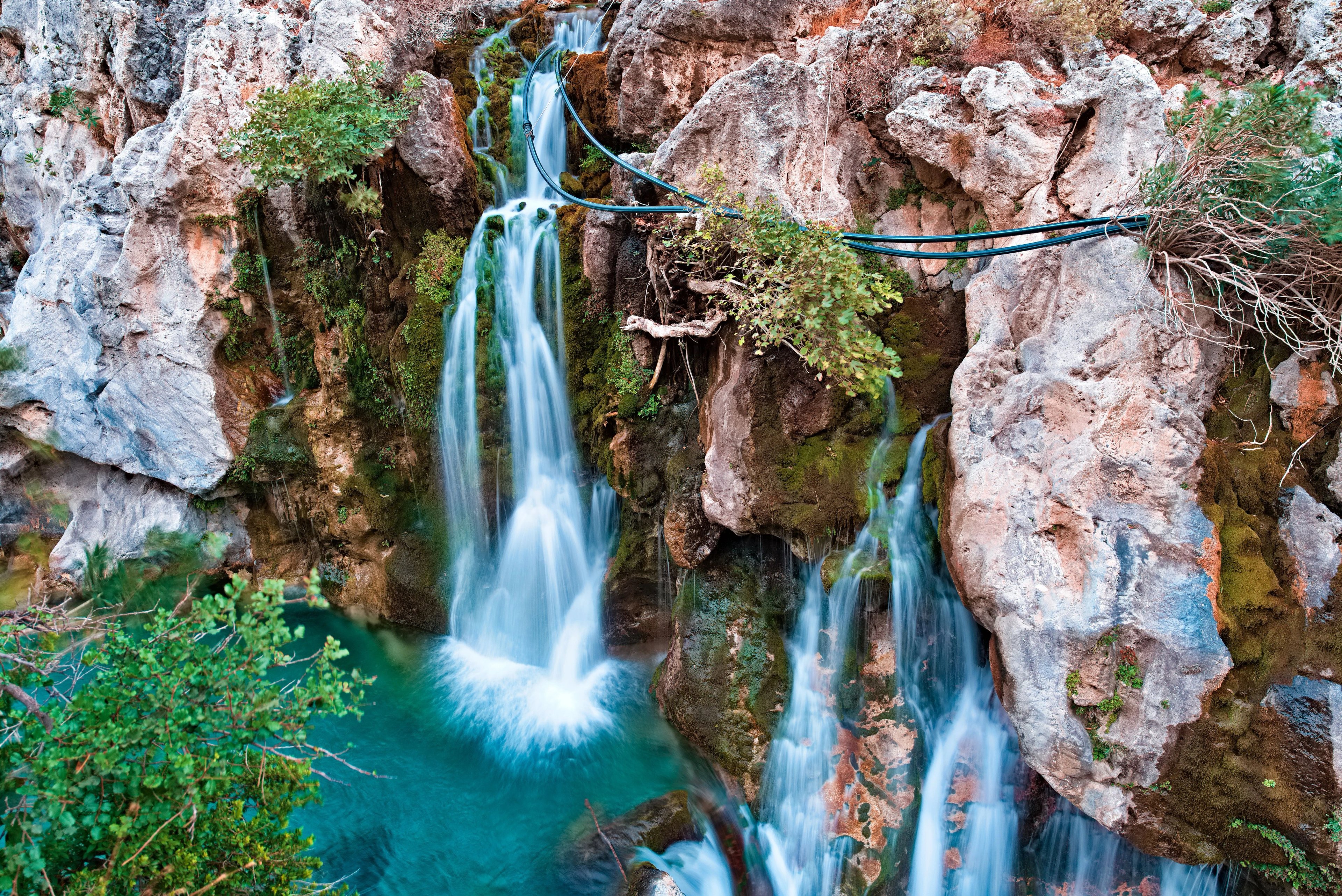
Ride through traditional villages and dramatic gorges, where towering cliffs frame winding roads. Stop in Spili to see its Venetian fountain before continuing through the spectacular Kourtaliotiko Gorge.
Distance: ~90 km
Elevation: +1,550 m
Surface: Paved gorge roads; occasional loose gravel on steep descents.
Day 7: Agios Antonios

A demanding mountain stage with steady climbs and rugged views of the Psiloritis Peaks. The route passes the Agios Antonios Gorge and reaches the highest elevation of the tour, offering unforgettable panoramas.
Distance: ~110 km
Elevation: +2,470 m
Surface: Fully paved; long, demanding climbs and technical downhill stretches.
Day 8: Triopetra

End your journey with a coastal finale to Triopetra Beach, a striking cape of rock formations and clear blue water. A rewarding climb to Melambes leads to breathtaking sea views before a final gentle descent back to Agia Galini.
Distance: ~55 km
Elevation: +1,340 m
Surface: Paved coastal and mountain roads; rougher asphalt near villages.
Day 9: Departure
Enjoy a final seaside breakfast or a short coastal stroll before departing — or extend your stay to explore Crete’s beaches and villages at a slower pace.
Trip Map:
Highlights to See
Cycling across Crete is more than just an athletic feat — it’s a journey through changing landscapes, ancient history, and timeless island life.
From mountain villages to archaeological landmarks and sunlit coasts, every stage reveals a new side of Greece’s largest island.
Here are some of the key highlights you’ll encounter along the way:
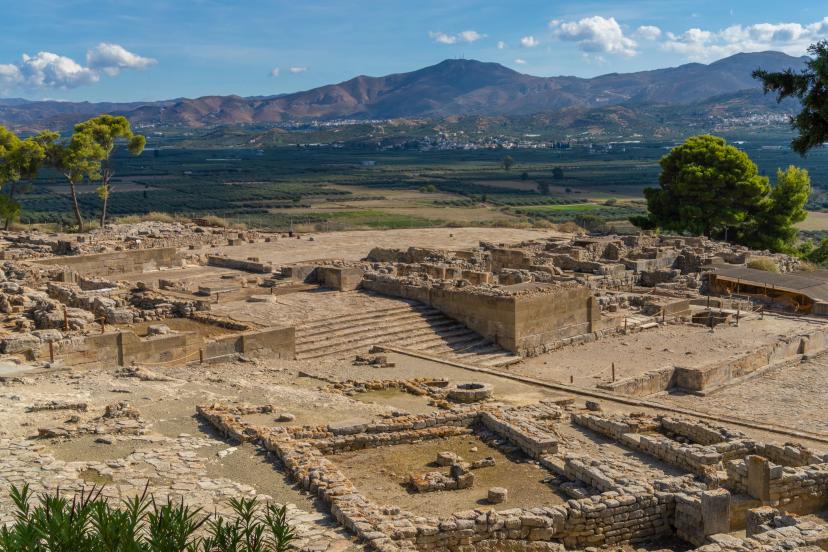
Festos Minoan Palace
Perched on a hill overlooking the fertile Messara Plain, Festos was one of the most important centers of Minoan civilization, dating back to around 1900 BC. The palace complex features grand staircases, courtyards, and storerooms that reveal the sophistication of Bronze Age Crete. Unlike the more restored Knossos, Festos retains a raw, archaeological atmosphere that feels authentic and open to the elements. From the upper terraces, you can enjoy sweeping views of the Psiloritis Mountains and the olive groves below — a timeless Cretan landscape that connects past and present.

Matala
Matala gained fame in the 1960s as a haven for artists and travelers who lived in the ancient cliffside caves overlooking its bay. Those caves, once used as Roman tombs, still line the sandstone bluff above the turquoise water. The village’s mix of mythology—legend says Zeus swam here with Europa—and free-spirited charm gives it enduring appeal. Today, Matala blends archaeology, music, and beachside ease in equal measure.

Zaros
Zaros sits on the fertile slopes of Mount Psiloritis, Crete’s highest peak at 2,456 meters. The area is famed for its natural spring water, ancient olive mills, and the peaceful Votomos Lake at the village edge. Byzantine chapels and hiking trails connect Zaros to Rouvas Gorge, offering a tranquil mix of culture and nature. It’s one of inland Crete’s best examples of traditional Cretan village life.

Asterousia Mountains
The Asterousia range stretches for over 40 kilometers along Crete’s southern coast, rising steeply from the Libyan Sea. Once home to hermit monks, it remains one of the island’s most remote and untamed regions. Villages like Kapetaniana cling to the cliffs with sweeping views down to secluded coves. Narrow mountain roads, olive terraces, and silence define this wild corner of Crete.

Triopetra Beach
Named after its “three rocks,” Triopetra is a quiet beach area about 52 kilometers south of Rethymno. Long stretches of golden sand meet crystalline waters at the mouth of the Akoumianos River. The surrounding hills are dotted with olive groves and family-run tavernas serving fresh seafood. Its sweeping sunsets and unspoiled horizon showcase Crete’s southern coast at its most elemental.
What to Pack?
Packing smart ensures a smooth, comfortable ride across Crete’s varied terrain — from coastal roads to mountain climbs. The island’s weather can shift between sunny coastlines and cooler highlands, so it’s best to be ready for both warmth and wind.
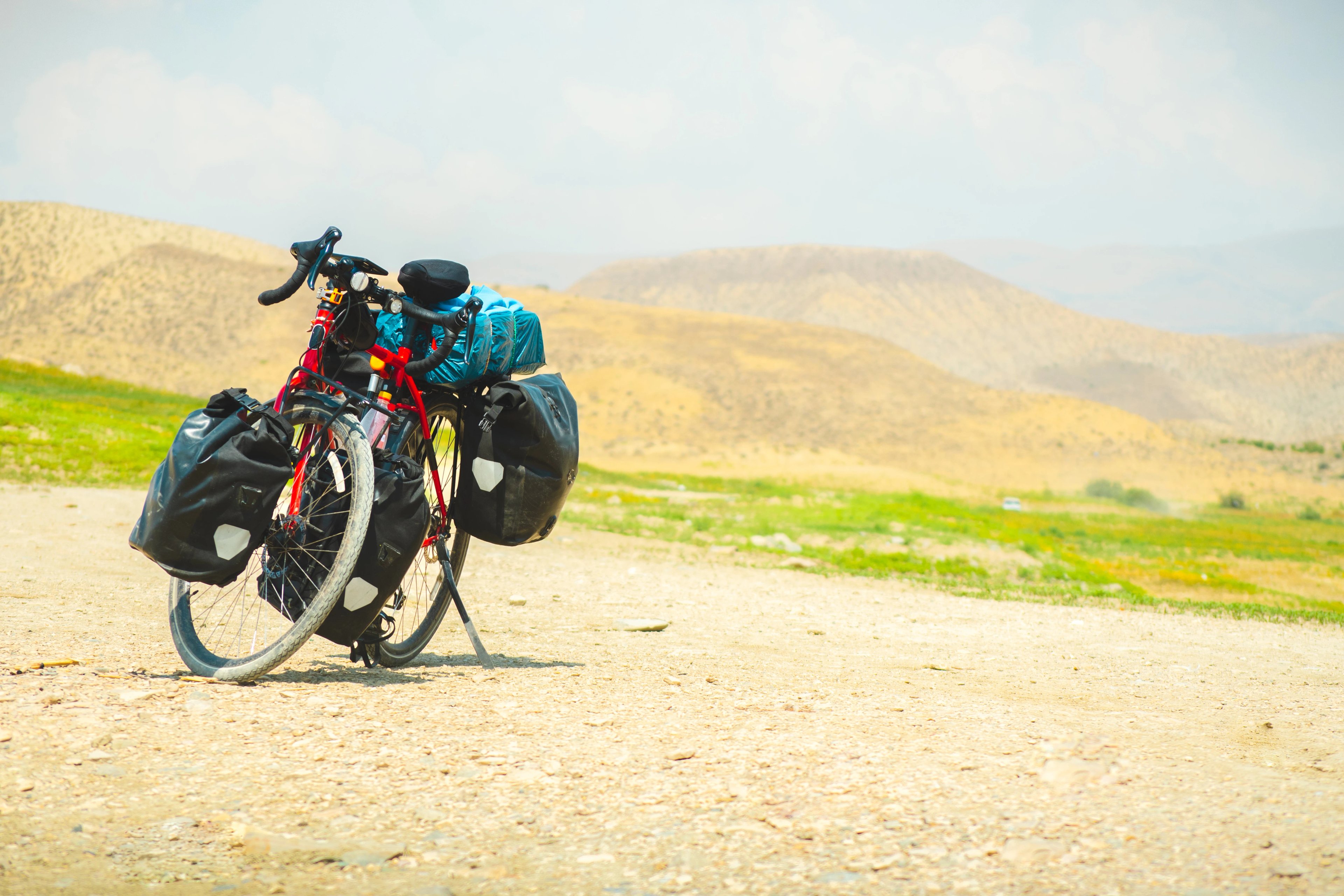
Must Have:
- Cycling clothing: Lightweight jerseys, padded shorts, and a breathable windproof jacket for cooler mountain descents.
- Sun protection: High SPF sunscreen, sunglasses, and a cap — Cretan sun can be intense even outside midsummer.
- Footwear: Comfortable cycling shoes or sturdy trainers suitable for short walks around villages or archaeological sites.
- Helmet & gloves: Essential for safety and comfort, especially on longer climbs and fast descents.
- Navigation & accessories: GPS or phone mount, power bank, and spare batteries — some rural routes have limited signal.
- Hydration & snacks: Two refillable water bottles and light energy bars; fountains and cafés are frequent but spaced apart in remote areas.
- Evening wear: Lightweight, casual clothes for relaxed dinners in seaside tavernas or mountain guesthouses.
- Documents & essentials: ID, travel insurance, small first-aid kit, and some euros for local shops and cafés that may not take cards.
Nice to have:
A few extras can make your trip even more enjoyable and convenient.
- Swimwear: Perfect for spontaneous dips at beaches or hotel pools.
- Compact bike lock: Useful for short sightseeing or café breaks.
- Quick-dry towel or laundry line: Handy for washing gear during multi-day tours.
- Reusable shopping bag: Great for carrying fresh fruit or picnic supplies.
- Notebook or travel journal: Capture memorable climbs, meals, or hidden viewpoints along the way.
For more preparation tips, packing suggestions, and route advice, see our Ultimate Greek Cycling Guide — your complete resource for planning the perfect ride across Crete and beyond.
Getting to the Start — Crete
Starting your cycling adventure in Crete is simple — the island is well connected by air and sea, with smooth transfers to your first hotel. Once you arrive, everything from accommodation to daily luggage transfers is arranged for you — all you need to do is show up and enjoy the ride.

By Air
Crete has two main international airports: Heraklion (HER) and Chania (CHQ), both offering frequent flights from Athens and major European cities such as London, Vienna, Paris, and Munich.
- Heraklion Airport: The most convenient for starting tours on the island’s central or southern coast.
- Chania Airport: Ideal if you’re extending your stay in western Crete.
Taxis, private transfers, and local buses connect both airports easily to your first overnight destination.
By Ferry
If you prefer a scenic arrival, ferries run daily from Athens (Piraeus Port) to Heraklion, Rethymno, or Chania, with overnight options available. Bringing your own bike is also possible with advance booking.
Arrival Logistics
Upon arrival, you’ll receive a detailed briefing with route notes, maps, and app navigation access. Hotels are pre-booked, and your luggage will be transferred between stages each day, allowing you to travel light and focus fully on the cycling experience.
If you need help arranging your flights or transfers, simply let us know — we’ll help you choose the most convenient option and ensure a seamless start to your Cretan journey.

Your Cycling Adventure Awaits
The Ultimate Crete Cycling Challenge captures everything that makes cycling in Greece unforgettable — dramatic mountains, quiet coastal roads, ancient ruins, and authentic island hospitality.
With our fully organized tour, you can enjoy the freedom of self-guided cycling without the stress of planning. We take care of the details — curated GPS routes, handpicked hotels, luggage transfers, and airport pickups — so you can focus entirely on the ride.
If you’d like help tailoring your trip or adding extra days to explore Crete’s beaches or mountain villages, simply plan a meeting with us — our team will be happy to help craft your perfect Greek cycling holiday.

Hassle-Free
We handle itineraries, accommodations, and anything else you prefer not to deal with, so you can enjoy a carefree holiday.

Completely Customizable
Flexibility is our middle name — whether you want more or less, or just beyond ordinary, we’ll make it happen.

Book with confidence
We are a financially protected company, fully bonded and insured, keeping your money safe and allowing you to travel with confidence.

Unbeatable support
Our 24/7 customer support is where we show our passion, bringing you a better experience by making your well-being our number one priority.

.jpg&w=3840&q=75)
